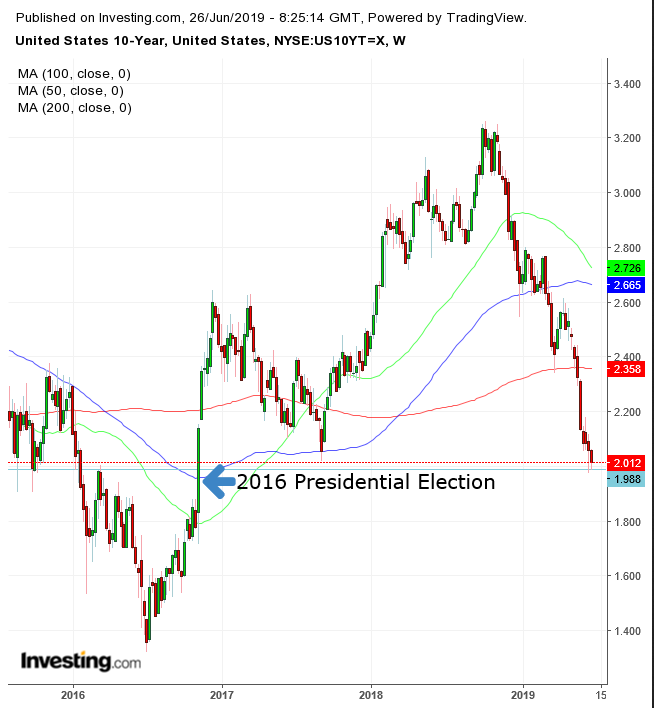- U.S. Mnuchin's trade deal optimism helps U.S. futures rebound from Fed-led losses
- European, Asian shares subdued on tempered rate cut expectations, caution ahead of key Trump-Xi talks
- Bitcoin hits 18-month high, eyes $13,000 level
- Oil climbs on mounting macro pressures
- The Group of 20 two-day summit kicks off is in Osaka, Japan, on Friday.
- The U.K.’s FTSE 100 fell 0.1%.
- The MSCI Emerging Market Index declined 0.1% to the lowest in a week.
- The MSCI Asia Pacific Index slid 0.4% to the lowest in a week.
- The Dollar Spot Index gained more than 0.05%.
- The euro declined 0.1% to $1.136.
- The British pound slipped 0.1% to $1.2671, the weakest in a week.
- The Japanese yen fell 0.2% to 107.45 per dollar, the weakest in a week on the largest fall in more than two weeks.
- The yield on 10-year Treasurys advanced two basis points to 2.00%.
- Germany’s 10-year yield increased less than one basis point to -0.33%.
- Britain’s 10-year yield gained less than one basis point to 0.797%.
- WTI gained 2.1% to $59.04 a barrel, the highest in more than four weeks.
- Gold dropped 1.1% to $1,407.27 an ounce, the first retreat in more than a week and the biggest drop in almost 11 weeks. The yellow metal remains on track for "monster" gains in June, having benefited from numerous macro headwinds that boosted investors' safe haven demand.
Key Events
Futures on the S&P 500, Dow and NASDAQ 100 shrugged off yesterday's sharp selloffs this morning, as traders processed an apparent hawkish shift in Fed rate outlook and rising Mideast tensions ahead of a weekend that is set to be monopolized by crucial U.S.-China trade talks.
It was mostly U.S. Treasury Secretary Steven Mnuchin to help U.S. contracts rebound from a weaker opening by saying the U.S.-China trade deal is 90% completed—further boosting investor hopes after Bloomberg reported the U.S. is willing to suspend the next round of tariffs on an additional $300 billion of Chinese ahead of this weekend's paramount meeting.
The STOXX 600 also managed to crawl into green territory after initially sliding for the fourth consecutive day. Keeping a lid on prices in the early session:
1. Tuesday's suggestions, by Federal Reserve Chairman Jerome Powell, that markets overplayed a potential interest rate cut. James Bullard was yet more direct, arguing the current market environment doesn’t warrant the half-percentage point cut priced in by most investors.
2. Investor caution ahead of the much-anticipated meeting between Trump and Chinese President Xi Jinping at the G20 summit in Osaka. Automobile producers, which are dependent upon affordable and smooth international shipping, underperformed other sectors at the open, also pressured by U.S. President Donald Trump's doubling down on threats to slap hefty tariffs on European auto makers last week.
In the earlier session, most Asian shares closed lower. Citi's Chief Investment Strategist, however, struck a more positive note for the region when he said the U.S. investment bank has maintained an overweight exposure to Asian markets since the trade dispute first emerged. The bank sees value in the region, which it considers under-invested at present due to trade war-driven selling.
Confirming the extent of the trade-war downward effect, a Reuters poll showed that South Korean exports are set to post their biggest fall in more than three years and their seventh straight month of declines in June. The report turned South Korean shares into the heaviest fallers of the day, followed by those on Japan's Nikkei 225, which also took a hit from falling domestic exports. Japanese stocks are also being hit by the country's current monetary policy stance—which appears relatively hawkish when compared with the global loosening trend—and by news of a looming raise in consumption taxes. Finally, a stronger yen—on both the central bank’s sudden relative hawkishness and on growing safe haven demand—makes equites more expensive via the exchange rate for foreign investors.
Global Financial Affairs

Yesterday, U.S. equities dropped for the third consecutive session. The losses marked the longest losing streak since May 9 for the S&P 500 (-0.95%) and the most extended decline since May 1 for the NASDAQ Composite (-1.51%), with U.S. tech firms taking the brunt of a trade war that is, really, a war for technological dominance.
The selloff was the result of investors recalibrating their expectations for a lower-rate environment, as they registered Powell's words as much less aggressive than his previous statements.

The perceived shift boosted yields on 10-year Treasurys, after they closed below the key 2.00% mark on Tuesday, for the first time since Nov. 8, 2016—at the start of Trump's presidency. In other words, as of yesterday yields erased all their Trump-era gains.
The lower expectations for lower rates also boosted the dollar. However, we consider it a correction within a downtrend, after the greenback fell below the uptrend line and the 200 DMA. However, by late European morning the USD had already pared much of its early advance.

Bitcoin resumed a surge to come within spitting distance of the $13,000 level for the first time since January 2018. Strengthening the Bitcoin jump: mounting expectations around Facebook’s Libra, which could turn crypto markets mainstream; financial crackdowns in India and China, which are driving people to move into the unregulated digital currency market; and—first and foremost—the expected “halvening” of mining rewards in 2020. Overall, analysts are expecting the current rally to differ from Bitcoin's boom-and-bust cycle of 2017/2018.
WTI crude surged as investors weighed escalating tensions between the U.S. and Iran against the possibility of OPEC+ extending production cuts.
Up Ahead
Market Moves
Stocks
Currencies
Bonds
Commodities
